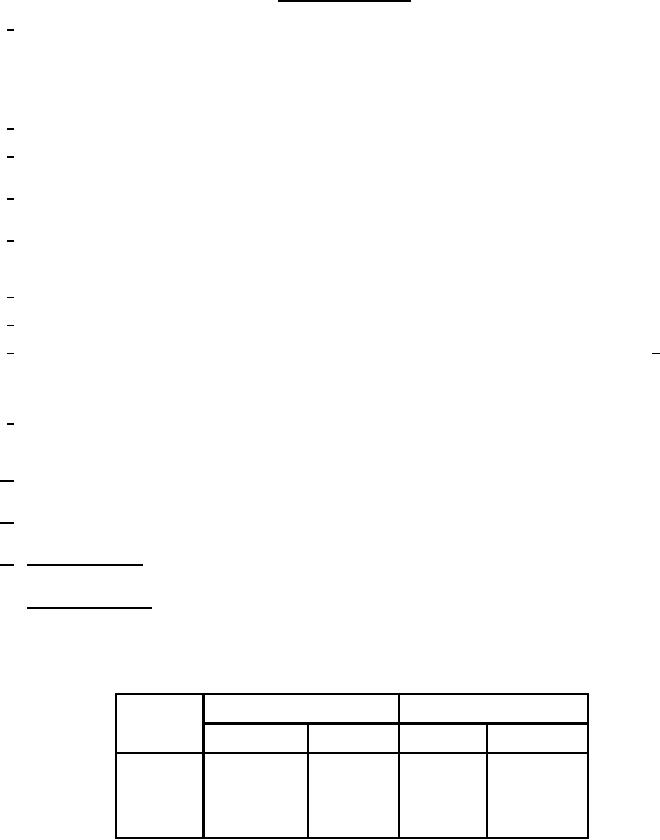
MIL-PRF-1/1633B
TABLE I. Testing and inspection - Continued.
1/ The transit time heating effect of the cathode shall be compensated for by a reduction in heater voltage after dynamic operation of
the tube has started. The back heating is a function of frequency, grid current, grid bias, anode current, duty cycle, and circuit
design and adjustment. There is an optimum heater voltage that will maintain the cathode at the correct operating temperature for a
particular set of operating conditions. A maximum variation of ± 5 percent from optimum is permitted. No reduction in heater voltage
is required up to and including 500 MHz. W here emphasis is placed on long and reliable life, the heater voltage can safely be
lowered to 6.0 volts, providing the line voltage is regulated to ± 2 percent or better.
2/ 1,200 volts is at the crest of the audio wave.
3/ The regulation, or series anode supply impedance, or both, shall limit the instantaneous peak current, with the tube considered as a
short circuit, to a maximum of 10 times the specified maximum current rating.
4/ The maximum instantaneous peak grid voltage for CW ratings shall be within the range of +30 to -400 volts. The maximum
instantaneous peak grid voltage for grid-pulse conditions shall be within the range of +250 to -750 volts.
5/ Sufficient conduction, convection, and forced-air cooling shall be provided to limit the envelope and anode shank temperatures to the
specified maximum value under all operating conditions. Reliability shall be seriously impaired if this maximum is exceeded. W here
emphasis is placed on long and reliable life, lower temperatures shall be maintained.
6/ Operation at this altitude is possible in a suitably designed circuit.
7/ This test is to be the first test performed at the conclusion of the holding period.
8/ Sufficient conduction or convection cooling, or both, shall be provided for all seals to limit temperatures in accordance with 5/. For
anode cooling, an airflow of 12.5 cfm minimum should be supplied at sea level with air at 25°C maximum, directed with a cowl as
shown on Drawing 157-JAN. W here long life and consistent performance are factors, cooling in excess of minimum requirements
is normally beneficial.
9/ In all electrical tests involving application of heater voltage, sufficient conduction or convection cooling, or both, may be provided for
all seals to limit temperatures. Unless otherwise specified, an airflow of 12.5 cfm maximum (at sea level, with air at 25°C) may be
supplied for anode cooling. The use of the cowl as shown on Drawing 157-JAN is permissible.
10/ Airflow through the anode radiator shall be between 3.5 and 4.0 cfm with the cowl as shown on Drawing 157-JAN. The grid current
shall be measured not less than 5 minutes after the anode dissipation has been set at 100 watts.
11/ Other tube contact configurations may be used provided the tube contact area remains unchanged and the socket, jig, or cavity
gives equal performance. Mounting of the socket, jig, or cavity may be at the option of the manufacturer.
12/ Grid-anode resonance. Test in cavity in accordance with Drawing 278-JAN. Cavity shall resonate at 1,354 ± 2 MHz with tuning
slug in accordance with Drawing 277-JAN at TA = 25°C ± 5°C.
Grid-cathode resonance. Test in cavity in accordance with Drawing 283-JAN. Cavity shall resonate at 1,719 ± 2 MHz with tuning
slug in accordance with Drawing 277-JAN at TA = 25°C ± 5°C.
W hen plotted on graphs of resonant frequency versus grid-anode capacitance and resonant frequency versus grid-cathode (input)
capacitance, the tube under test (TUT) shall be represented by a point within a parallelogram whose four corners are located by the
following points:
Capacitance (pF)
Frequency (MHz)
Points
Cgp
Cgk
Fgp
Fgk
1
2.10
7.0
1,935
1,765
2
2.10
7.0
1,965
1,795
3
2.40
9.0
1,870
1,725
4
2.40
9.0
1,900
1,755
4
For Parts Inquires call Parts Hangar, Inc (727) 493-0744
© Copyright 2015 Integrated Publishing, Inc.
A Service Disabled Veteran Owned Small Business